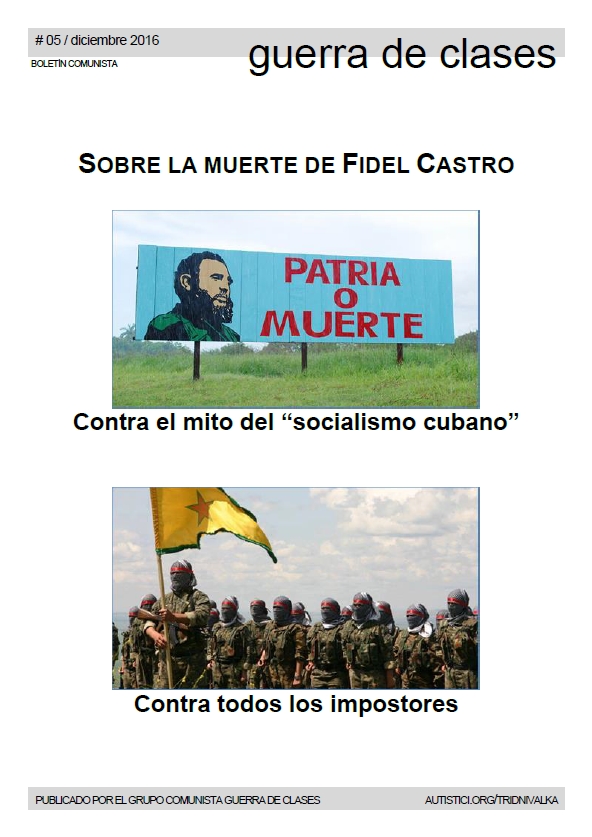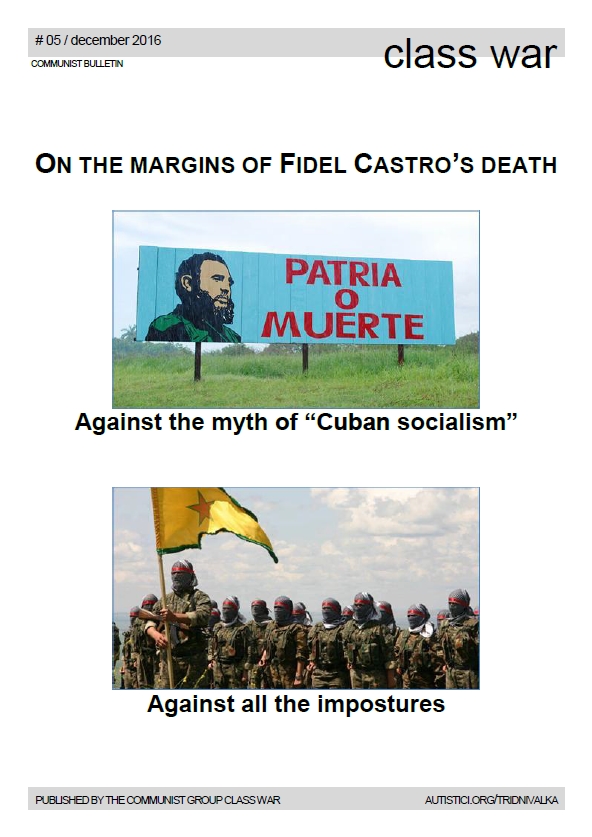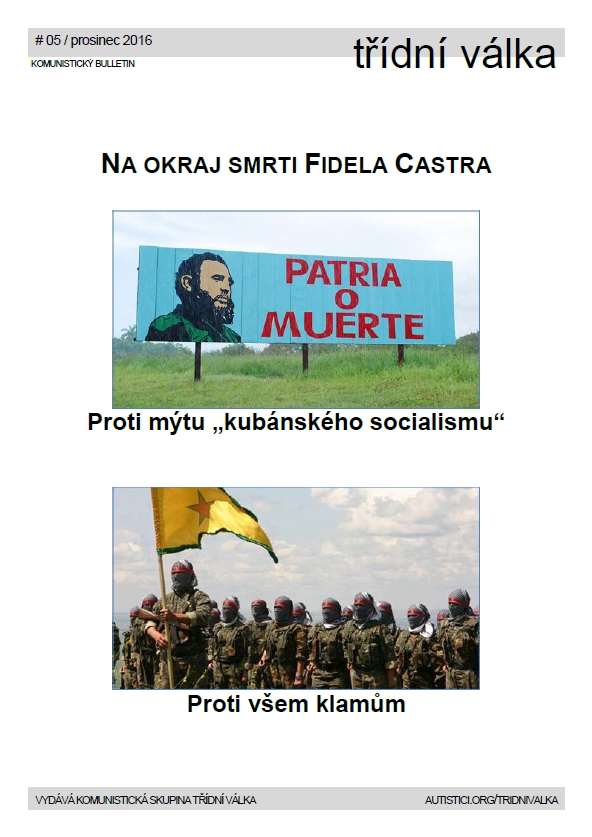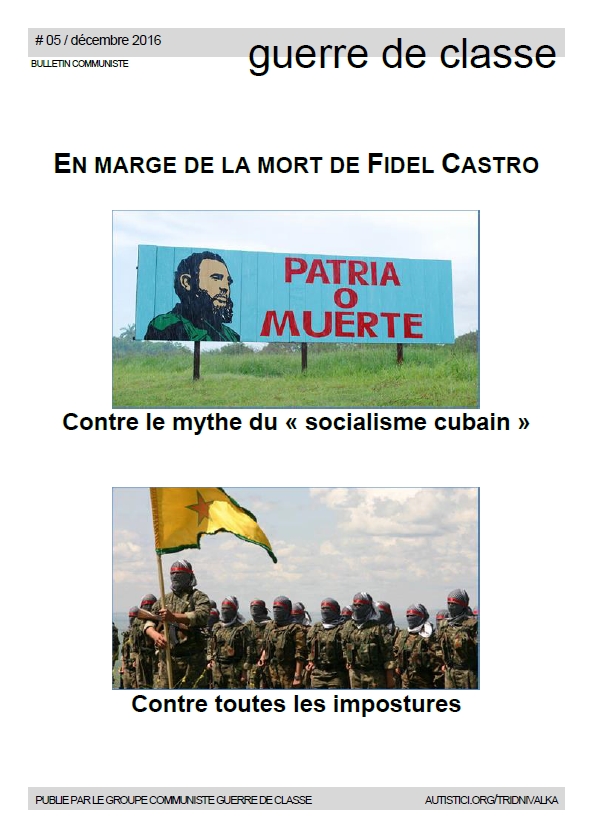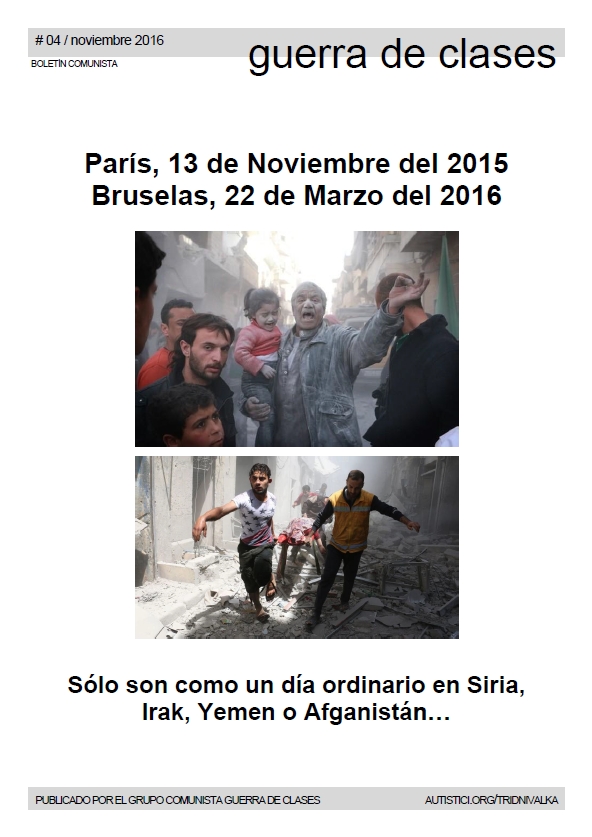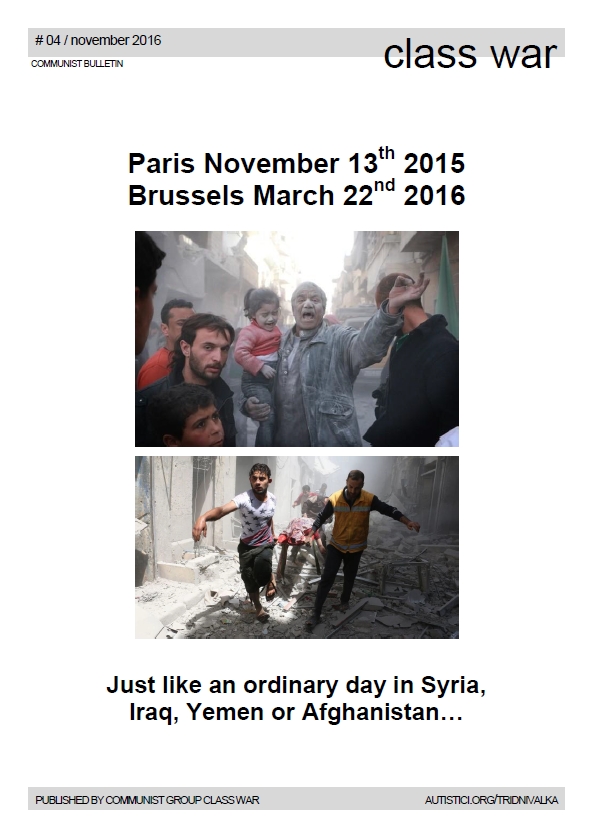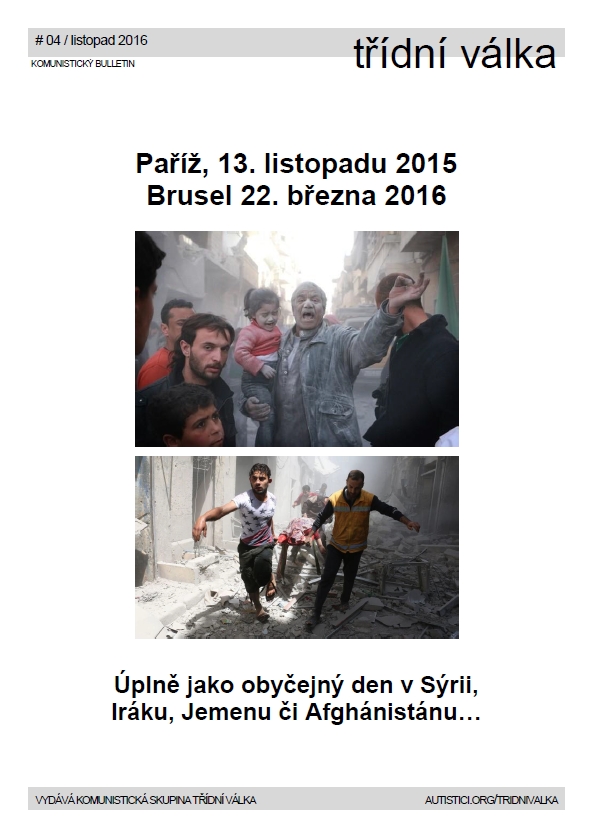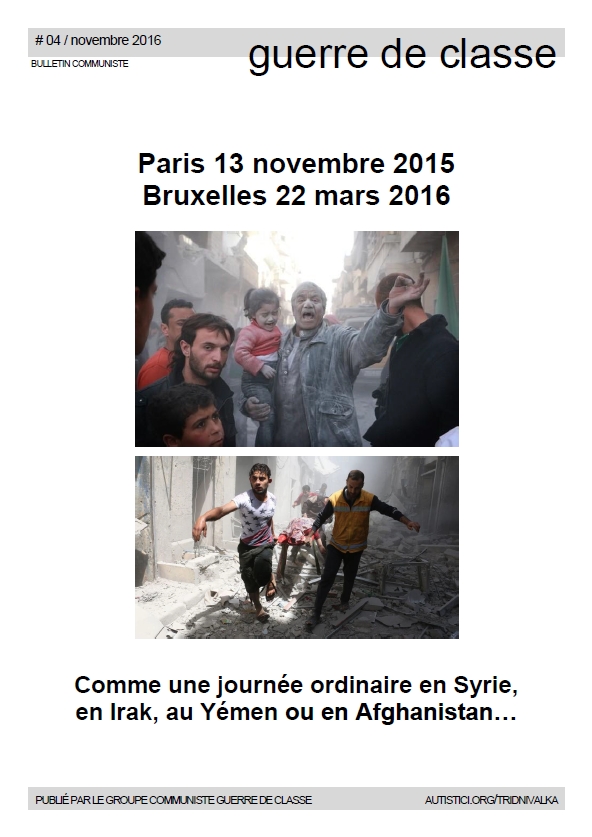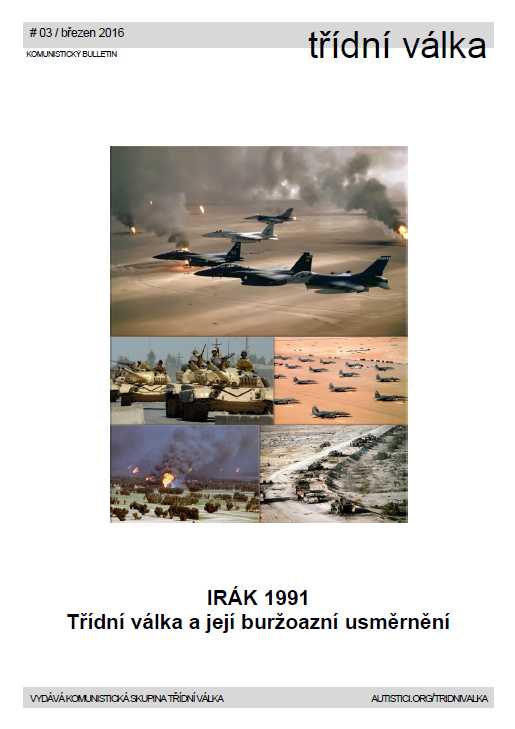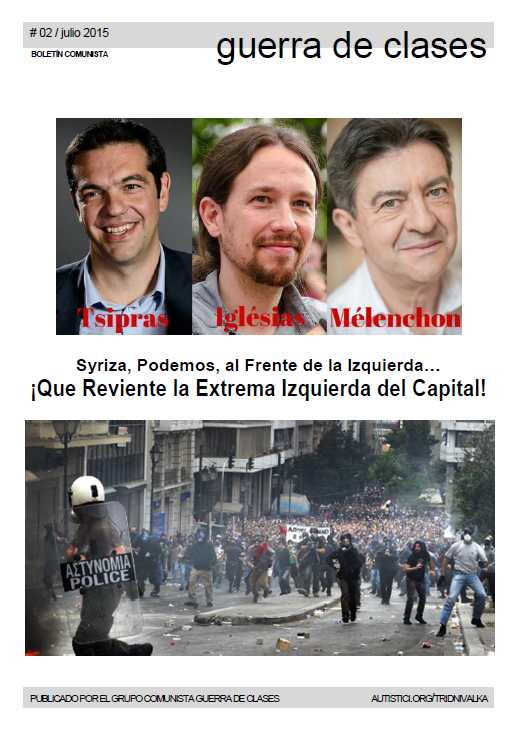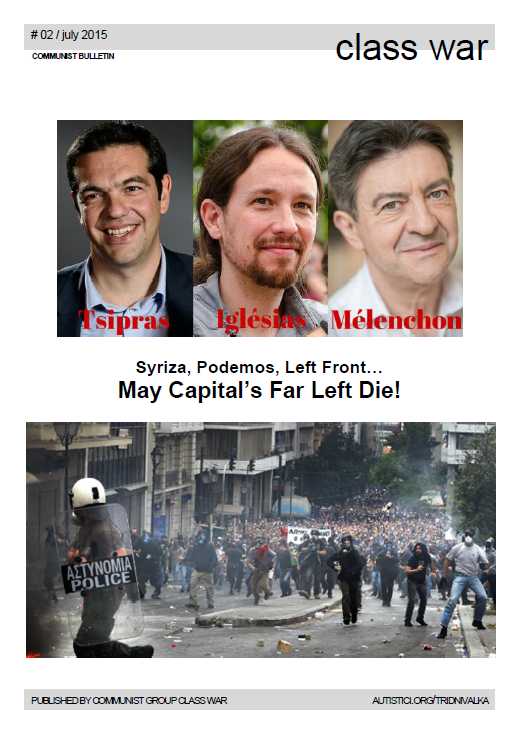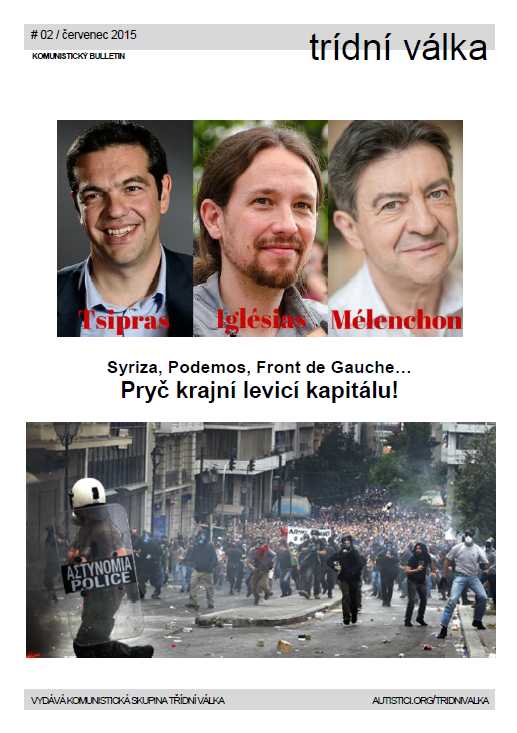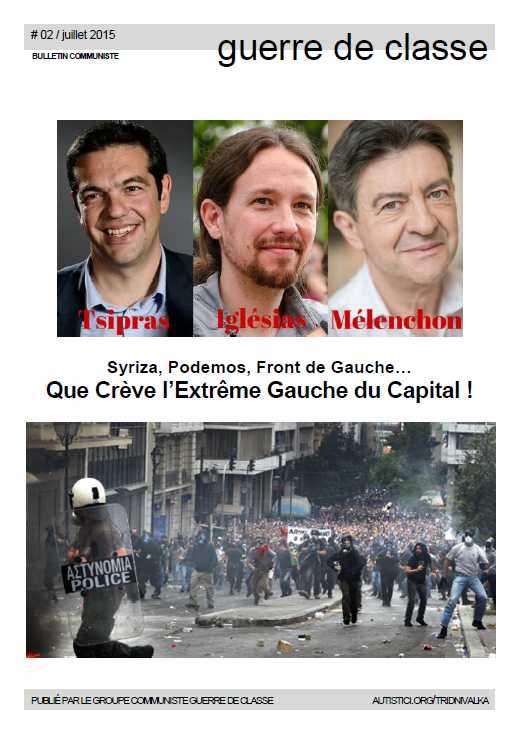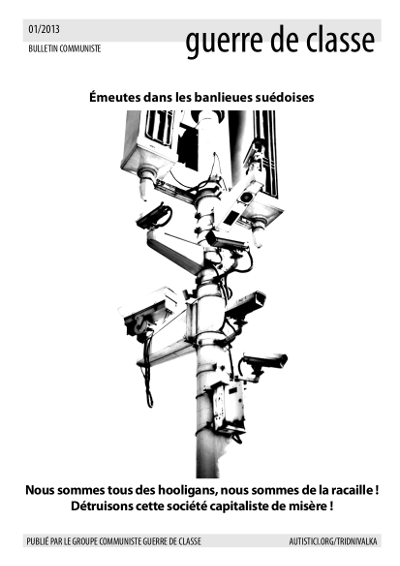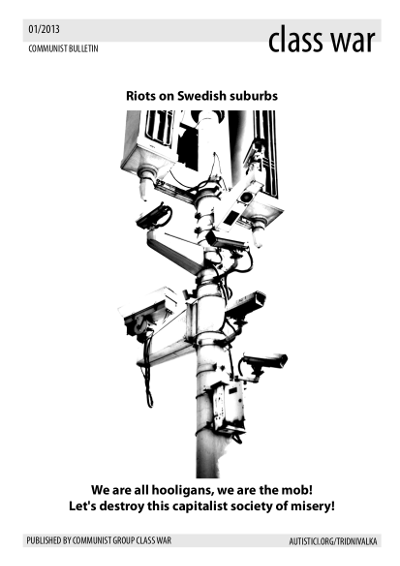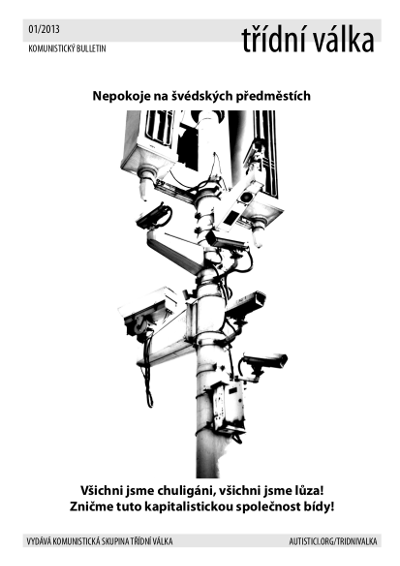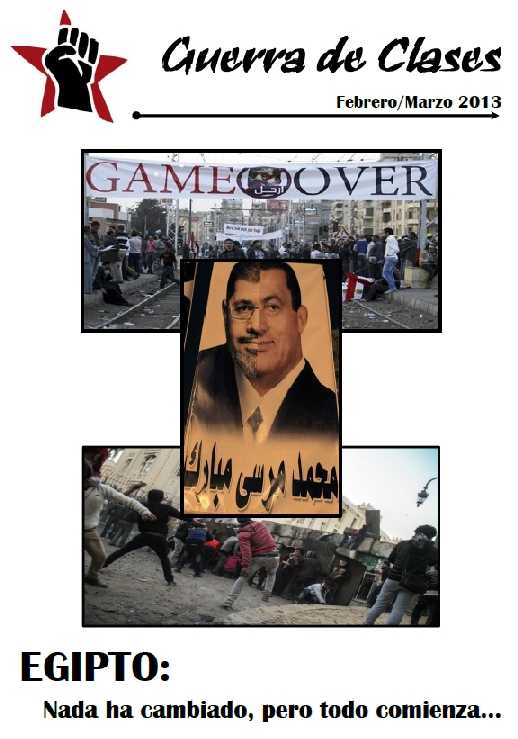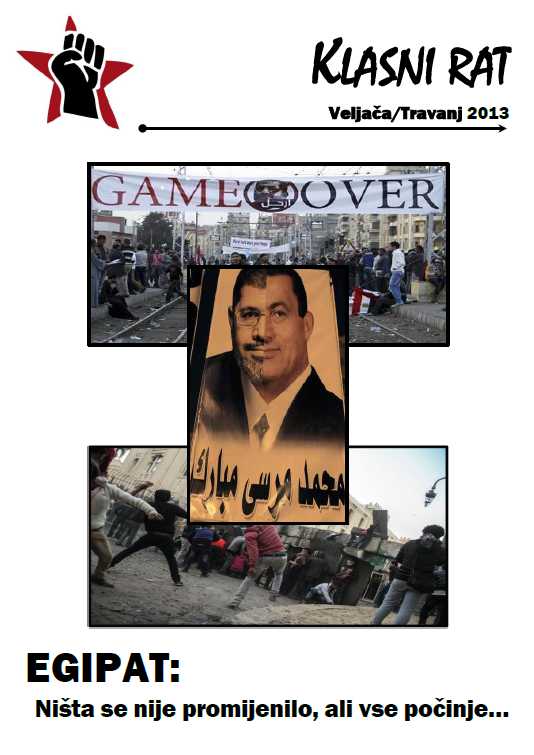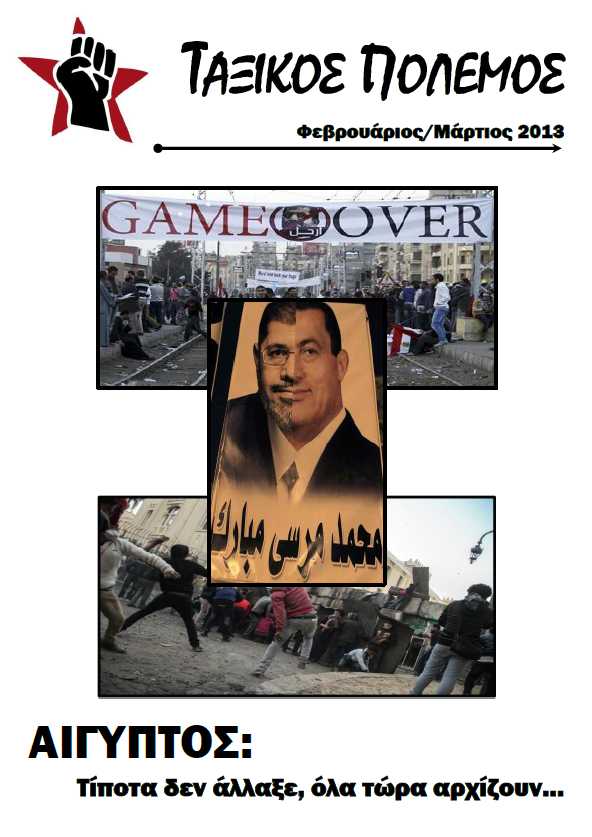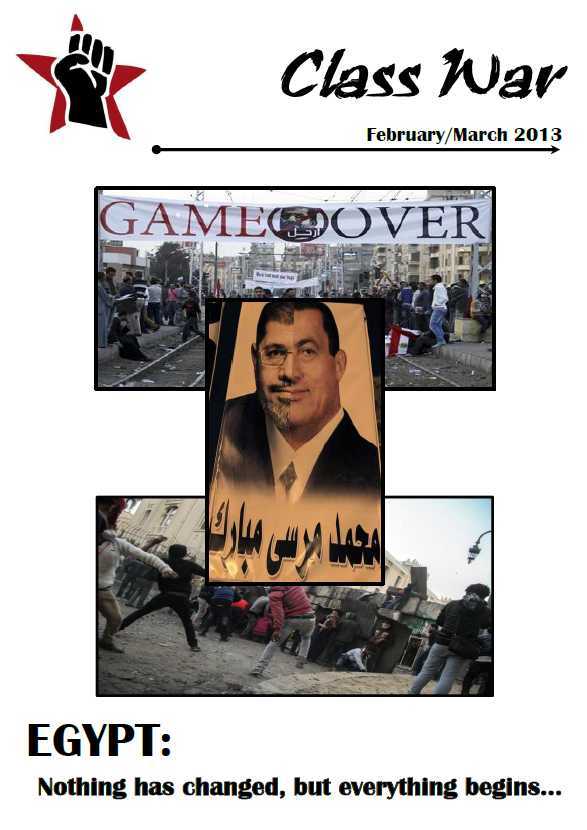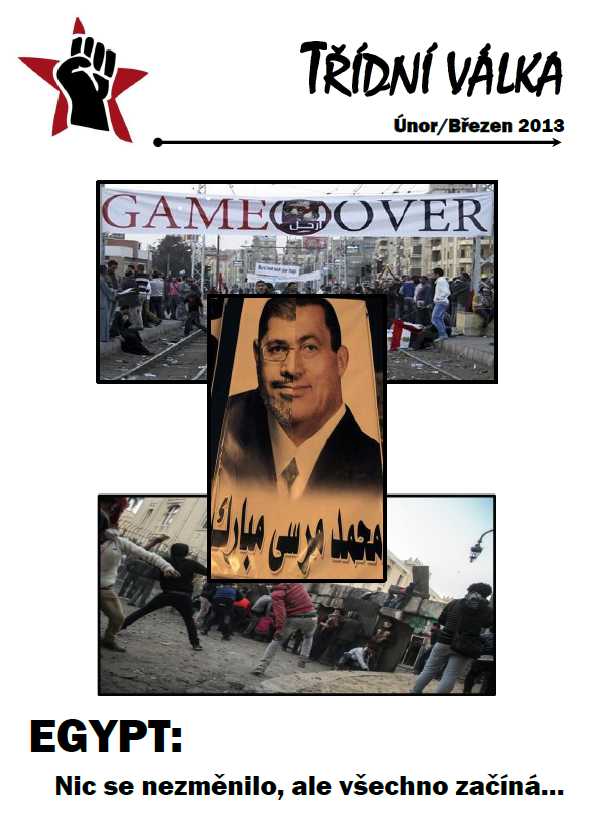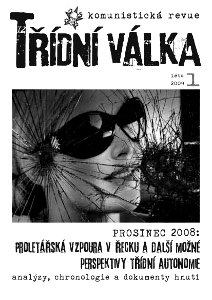 A German TV station, in order to mark the anniversary of the fall of “communism”, recently broadcasted a documentary about today‘s life of those who had participated in the general strike in Poland, 1980. In one of the most telling scenes of the documentary, workers of Gdansk shipyard are coming to an iron fence of one of the gates, they are laying flowers and then they are trying to spot through rungs at least something from the celebration in honour of the Solidarnosc, which, in attendance of celebrities and politicians and admission by invitation only, takes place inside.
A German TV station, in order to mark the anniversary of the fall of “communism”, recently broadcasted a documentary about today‘s life of those who had participated in the general strike in Poland, 1980. In one of the most telling scenes of the documentary, workers of Gdansk shipyard are coming to an iron fence of one of the gates, they are laying flowers and then they are trying to spot through rungs at least something from the celebration in honour of the Solidarnosc, which, in attendance of celebrities and politicians and admission by invitation only, takes place inside.
We believe, that this scene characterises the essence of the so called “revolutions” at the late 1980s more than anything else. That is why these “revolutions” are worthy of attention of communists (even though most of the anniversary celebrations are already over). It is not because they represent a peak of the struggle of our class, but on the contrary, because historically specific relation between labour and capital resulted in the fact that our class acted rather as the labour for capital and actively participated in its own defeat (in the historical, but not in the immediate sense).
The following contribution of the Class War Group is neither a chronology of events in Czechoslovakia, 1989, nor a description of them. It is an attempt at a general analysis of the so-called Velvet “Revolution”, which would classify it in the perspective of class struggle, the only perspective, which can provide it with a meaningful context and a meaningful explanation.
1.
Without regard to what participants themselves, journalists, politicians and others may think about, all those “revolutionary events” in November 1989 were nothing else than ending of one and establishing of another bourgeois project of managing capital, a project designed to maintain the highest possible rate of profit and to subordinate the proletariat as effectively as possible, that is to say a project of restructuring capital. And this goes for Czechoslovakia as well as for the entire Eastern Bloc. “The carnival of revolution” might have taken the Czechoslovakian Communist Party (CCP) and the opposition by surprise, but from the perspective of capital this historical motion represented a completely logical consequence of the previous period.
A necessity to reform the Stalinist administration of capital (i.e. the efforts to submit economic forces to the state control) had manifested itself in Czechoslovakia already since the mid-1960s and it represented nothing exceptional in the history of capital. However, it was not due to enlightenment of the “reformist” faction of the ruling class, which then accentuated the need for a change. The political dictatorship, which pacified and disciplined the proletariat after the World War II, together with a planned economy artificially deforming the process of value valorising itself, which had permitted fast start up of a new cycle of capitalist production, both, after twenty years of good service, simply became barriers for further development. The Stalinist form of production relations became an obstacle for further development of production forces which would correspond to requirements of the world market and, thus, it approached the end of its capacity to effectively reproduce capital as a social relation. It proved plainly in 1963, when the third five-year plan failed and when the GDP entered a slump for the first time since 1948. In short, “enfant terrible” of capital simply grown up of the tight shell of Stalinist management and demanded what could allow it to continue the accumulation – reforms of market and democracy, the economic and political liberalisation.
The bourgeoisie has, of course, never been fully aware of all of these processes in capitalism. Its driving force was and still is the profit. The same goes even for the Stalinist bourgeoisie, irrespective of how vigorously it tried to disguise this fact, and regardless of how it tried to hide its own existence as a class. Inefficient production and unsatisfactory consumption, crisis of valorisation in short, which led to a decrease in the profit, and an effort of the ruling class, then represented by higher levels of the state-party bureaucracy and an economic technocracy, to reverse this development – these were the real reasons why Action programme, approved by the CCP in early April 1968, as for the question of an economic reform declared: “We put much hope in restoring positive functions of the market as a necessary mechanism for operation of the socialist economy and an inspection of whether work in enterprises has been spent in socially expedient way. But we do not envisage a capitalist market, but a socialist one, and not its unrestrained, but controlled use. The plan and national economic policy must appear as a positive force in the direction to standardise the market, against tendencies of economic imbalances and against monopolism in controlling the market.”
Reluctance of “hard-line” Stalinists to face the economic problems and to adopt this progressive programme (progressive from the point of view of capital), and their subsequent political and military victory over “reformists” put the reform into cold storage. However, the need for restructuring and change of social management, stemming from needs of capital, finally proved to be always more necessary and the only solution, which at the end of 1980s posed as unavoidable.
Let’s try now to briefly answer the question, why there emerges a need for restructuring the capital relation in 1960s and 1980s. On the basis of what we have learned so far, we came to the conclusion that the Stalinist model at its beginning gambled on a brutal increase in extensive exploitation of the proletariat (it herded as many people as possible to production, it prolonged working hours in an open or a hidden way and it tried to attack the direct wage as well as social benefits). The limit of this way of extracting the surplus value was the class struggle. First of all, there was a widespread “hidden” resistance in the form of absenteeism and floatation plaguing the Czechoslovakian economy since the end of the Second World War (and having its roots even in the Nazi Protectorate), which after February 1948 took a form of avoiding the obligation to work for a part of a young generation. In 1951 an open resistance appears in the form of wildcat strikes and smaller riots in an industrial city called Brno and its surroundings and later in 1953 (in connection with a monetary reform) in the form of wildcat strikes and riots in Pilsen and many other cities. Although these struggles were defeated and the working class was disciplined again, the threat of the previous struggles and in the same year the rebellion in Eastern Germany and subsequently the revolt in Poland and the revolution in Hungary in 1956 made the ruling class of the Soviet bloc to adopt a directive saying that socialism cannot be built against the working class, but only together with it. In practice it often meant freezing of rate of exploitation or even its reduction. That is exactly what brought the Czechoslovakian economy in the early 1960s into a crisis and what put on the table the question of transition from the extensive exploitation to an intensive one (an intensification of work connected with technological innovations and social consequences related to this intensification). We believe that the fear of possible impacts, which this transition could have on a proletarian struggle, motivated the Stalinist nomenclature to repress the Prague Spring. For the same reason, the period of normalisation didn’t bring anything new, no fundamental restructuring of the relation capital-labour. Therefore, the whole economy and the society were gradually falling into stagnation, dysfunction and decomposition, which called for other efforts to make a reform, which became more and more acute.
It was precisely this urgent need of capital to restructure itself, which produced bearers of the necessary changes in the shape of a pro-reform faction in CCP, opposition economists and dissidents. And it was the same need to reform the production, and a possibility to do so, the possibility opened by events set off by repressing the students protest demonstration of November 17, what made the pro-capitalist opposition to cooperate with the so-called pragmatics from the CCP. Therefore, it was this very perspective of an economic crisis and a real political crisis what in November 1989 united the dissent and some parts of official power and what forced them to overcome mutual animosity in favour of a united front of “struggle” for clearing the way for further development of capital, i.e. removing all obstacles of the Stalinist state-controlled economy and its political forms.
Let’s make a little excursion to what we mean, while speaking about the bourgeoisie and its factions, which were interested in political and economic liberalisation. We don’t grasp the bourgeoisie in a sociological sense. It is not only the class of factory owners or of those driving Mercedes cars. It is a class of those who live on exploitation of the proletariat, who organise and manage this exploitation. It is not defined by a simple ownership de jure, but rather by real relation of power over means of production, by the fact that they are administrators of capital, they personify capital. And this relation may take various forms more or less hiding the essence of this association with capital. In contemporary liberal capitalism, this relation is among others represented by managers, who are de jure a kind of pseudo-wage-earners, but in reality they control means of production and live on surplus value, which was under their supervision produced by the proletariat. In the Eastern Bloc, this relation was represented by upper levels of the State and Party bureaucracy and technocracy, which legally owned nothing but de facto held power controlling both individual enterprises and the production as a whole. This was the bourgeoisie of Stalinism – real existing socialism.
The effort of these bureaucrats and technocrats to control individual and mutually antagonistic forces of capital through centralised economy, an effort so typical for all Stalinist state-parties in Eastern Europe, however had a side effect. At least since the end of 1970s and the beginning of 1980s, the more and more obvious failure of the economy, functioning in this way, led not only to very careful and unsystematic attempts of the central government to solve this situation through timorous doses of autonomy for individual companies and financial stimulus for their managements, but also to the growth of a black economy, which partially compensated for enormous deficiencies of the official economy. This framework then gave rise to a new social stratum, it helped it to gain larger or smaller sums of money, but at the same time it did not allow it to turn these finances into private capital, which would produce more money. It was possible just to “consume” these financial resources, but the possibilities of consumption offered in the “socialist” economy were limited too. This new social stratum didn’t consist only of various directors-general and assistants of large enterprises, but also of party apparatchiks responsible for individual industrial sectors, all mostly loyal party members, and also of various enterprising managers of shops with demanded and shortage goods, some moonlighting employees and last but not least, for example, underhand moneychangers. The existence and content of daily life of this social stratum members connected with the capital relation (even if it was a group significantly stratified) represented continuous pressure to release tied up economy, which would allow them to valorise accumulated exchange value and turn it into a real capital multiplied in exchange for labour. This pressure considerably participated in formation of a new political climate in the society, which contributed to economic and political liberalisation.
During the chance for a change, opened up by the November movement, the pro-capitalist dissent and economists from the Prognostic Institute, reorganized together in the Civic Forum (CF), appeared as the best representatives of the social motion giving birth to that new social stratum with business ambitions. The pro-capitalist dissent, we stress! Therefore, we speak neither about all dissidents as such nor about their organisations in general; we mean only those whose function in the social antagonism was in opposition to the interests of the proletariat, those who acted as a political faction of the bourgeoisie, without having all the means usually available for this class, those, who were tied together with capital by their programme and ambitions, without being its real administrators. Speaking about the pro-capitalist dissent, the political bourgeois factions in opposition, we mean those who vehemently claimed their right to become a part of the ruling class, while constituting an alternative to the ruling party, they claimed to be more and better trained to carry out power and they actively participated in developing a programme for the reform, which would enable them to enter the capital executive. Their united front with technocrats aspiring to become private owners, which was set up in November 1989, allowed them to complete this reform and to put themselves to (from their point of view) an appropriate place – to a control panel of politics and economy.
And although ones emphasised more economic liberalisation (in an effort to valorise accumulated values), while others emphasised rather political liberalisation (convinced that capital should be managed democratically and with respect for human rights), the liberalisation of both proved to be a common interest after all, since both were necessarily connected and a political revolution was a needful prerequisite for it. All those “forums”, “round tables” and leaders of the opposition and the regime jointly acting and hurrying hand in hand to establish democracy, all these were only different shapes of the temporary united front of forces of capital.
It was precisely this alliance what enabled the first negotiations between the opposition representatives (an initiative called The Bridge) and the Prime Minister as early as at night, November 18-19. One day later it was already a delegation of the Civic Forum, who held talks with the government and on November 28, that is to say only 11 days after the student demonstration, the old parliament unanimously cancelled a constitutional article on a leading role of the CCP in the society. A month later the same parliament thereafter co-opted new members and lastly it unanimously elected Vaclav Havel as the president.
This temporary alliance of individual reformist factions and forces of capital, even if technocracy itself and its allies from the dissent were not fully aware of that, expressed itself among others in the speech of Vaclav Havel presented at a demonstration of November 23: “The Civic Forum (…) disposes of qualified forces from all spheres of social life, which are capable of leading a free and pragmatic discussion about a realistic process of changing political and economic circumstances in our country.” For the same reason the future president addressed an action group of Coordination Centre of the Civic Forum on December 5, while speaking about the need to delegate to the government “a kind of our good representation (…) which would guarantee a continuity of power”.
So, this “revolution” passed quickly and broadly painlessly, the Stalinists were quickly replaced by democrats, sympathies to a socio-economic “change” occurred at once also in the highest stratums of power and the ruling faction vigorously worked on its own deposal. All this shows how great was the need of capital to get rid of the old and too tight shell of “socialism”, and how much the united capitalist forces struggled across opposition as well as government to fulfil this need.
This temporary unity across the bourgeoisie and the opposition of medium and lower level apparatchiks and other clearly pro-capitalist groups is the only explanation for all speculation and conspiracy theories, whether the November “revolution” was scheduled, what purpose it should serve to, whether it was commanded by the secret police or the CCP, etc. As we have already said, the bourgeoisie is not fully aware of its historical role, which is the preservation of capital, and it absolutely doesn’t act as a single conscious being. However, it is aware of its immediate interest – realisation of profit. It responds to the need of capital to valorise itself, it creates and changes conditions for this valorisation, and this is the essence of bourgeois politics. Even in times of crisis, when realisation of profit is in danger, if not for all the bourgeoisie, then at least for most of its factions, and the ruling class is forced to search for a solution as a united class, even in these tense moments of history there are always individual antagonistic interests of different factions, groups and individual capitalists, as well as those of social and political movements with capitalist ambitions and bourgeois programmes, interests hidden behind a facade of a common benefit. Therefore, although they fulfilled together the need of capital to disrupt borders erected by the Stalinist administration, these factions outwardly seem to be opposing each other. In this way they also grasped themselves as opposing each other and in this sense they also acted in public.
All the unclearness and speculations about possible agreements and secret interests are based exactly on the presumption that there were real oppositions and alternatives in the so called Velvet “Revolution”. However, in fact the only viable variant in the events of November 1989, was the reformist part of the bourgeoisie together with the dissent related to the perspective of reproduction of capital – i.e. those who claimed their right to become a part of the ruling class, united by capital in need of restructuring. The secret police or the CCP didn’t make any agreement with the opposition to change the regime, and neither such an agreement existed within the ruling party. All of the actors were connected (without being aware of it until the final consequences) only by the interest to reform management of capital in order to solve the crisis of profitability and reproduction of capital before it will strike in full drive (although they only succeeded to postpone it). All this, however, doesn’t change anything about the fact, that on the level of ideology they stayed hostile opponents, and so they were in their self-considerations and self-presentations.
However as soon as this programmatic capitalist alliance completed its historic task, as soon as it succeeded in eliminating old forms of the economic and social management and thus allowed capital to expand further, this united front broke up as the united interest of capital disappeared. Bourgeois factions competing with each other came forth with their mutually competitive interests, which have been since then derived from new cleavages brought by new management of capital.
Bourgeoisie of the Eastern Bloc was primarily established, organised and profiled via the ruling “communist” parties and the State. This way it also solved its inner conflicts. “Economic level” of its class position and forming of interests which derived from it (technocracy versus bureaucracy as its specific parts) and factional confrontations remained on the contrary, considering the defeat of reformist programme of 1968, secondary. November 1989, though, initiated the process of transforming the bourgeoisie in relation to capital, it redefined its relation to means of production and priority was given to (simply said) “economic level” of reproduction of the ruling class. From then on, it will no longer be the contradiction between the political bureaucracy and the economic technocracy what will form individual bourgeois factions, but individual capitals.
2.
The unaccommodating economic structure was not the only reason for reforming the management of capital. An equally important reason was a long-lasting practical inability of the bourgeoisie to effectively increase the rate of exploitation of the proletariat and thus to ensure a sufficient extent of profit. Both, constant and variable capital needed restructuring, the variable one, moreover, needed discipline to be imposed on it.
It has always been precisely the rate of exploitation of variable capital (i.e. labour force), what has been crucial for capital. Only the value extracted from living labour is a source of profit, and therefore it is necessary to permanently reduce that part of the working day in which the worker produces a compensation for his daily wage, and to extend that part when he “gives” its work to the capitalist without being paid for that.
The well known motto “we pretend to work and they pretend to pay us” was only one of expressions of a lack of the ruling class’s capacity to impose on workers an increase in exploitation or actually to make them accepting it. And this also goes for the entire Eastern Bloc, even though a resistance of the proletariat appeared in different countries in different degrees.
When the Polish government announced a global increase in food prices in the summer of 1976, proletarians replied by work stoppages in dozens of factories. Many went even further in manifesting their protest against these new governmental measures, which in effect increased their exploitation through decreasing real wages. Workers from a tractor factory Ursus prised up rails on the main railway line to the city, in Radom proletarians took to the streets and set on fire a building of the ruling party. One day after the government had announced the price increase; it already had to be withdrawn facing the untenable situation in the streets. Four years later the government tried to enforce price increase again (this time it was a question of price of meat) and it had to face class anger again. The strike was started in Ursus tractor factory, during two weeks the resistance spread throughout the country and there were already 350 thousand workers in strike. The government pressed by the four years of postponing the price increase, couldn’t give in this time and it violently repressed the movement. The bourgeoisie in such a situation (from its own point of view) necessarily had to massacre and to discipline non-obedient variable capital, but it definitely wasn’t a kind of standard and the most suitable conditions for valorisation of capital. The need for reform, which would make the exploitation of labour force more effective, arose before capital across Eastern Europe always more clearly.
The general economic situation of Czechoslovakia in 1980s was not as a disastrous as for example that one in Poland. Difficulties of capital to valorise itself, nevertheless, appeared in all spheres and the bourgeoisie was trying hard to make the working class pay the costs of the crisis of the so-called “Soviet model”.
The crisis, which had been ruining economy since the beginning of 1980s in such a way that companies from the COMECON countries even started to a large extent to barter among them, since money didn’t meet their function of a universal value equivalent, this crisis brought a decline of the bureaucratic planning and an increase in autonomy of the company technocracy. The bourgeoisie started to split up: Stalinist dinosaurs and political functionaries refused to face and solve the problems, while the faction more connected to the economic base of the system searched for the way to make the economy more efficient.
One of the expressions of this tendency was for example Gorbatchev with his “perestroika” and “glasnost” and finally even the Czechoslovakian reform itself. The CCP supposed to start this reform on its own since the 1st of January, 1990 and it justified it in its resolution “On Complex Transformation of the Economic Mechanism in the Czechoslovakian Socialist Republic and its Guarantees” in December 1987, while saying that “(…) it is necessary to provide for new quality of growth of the GDP which is a condition for a better satisfaction of real people’s needs (…) The results (…) of analyses clearly confirm that without a qualitative improvement (…) a space for the necessary changes (…) in a development of production forces (…) cannot be opened and, therefore, a space for social objectives of our society.”
The reform designed to reverse the drop in a total increase in production and productivity of labour considered the cause of the problems in defects of planning and state management and in a lack of motivation of companies (both management and employees). The reform’s pillar was a law on state companies that were to become independent economic units with their own economy and with limited central financing, subsidies and a plan given by the State, which was hereafter to play only a role of a framework: to prognosticate, to define a goal of the national economy, whose implementation, however, was to depend on individual companies. Foreign trade was to remain mainly in the hands of the State, but a part of the profit in foreign currency was to go directly to the enterprises. Foreign investors were to be allowed to enter in a form of joint ventures, where majority of Czech capital was to be preserved. Mainly the sector of service was supposed to be supplemented by allowing private business.
This reform, however, boded ill for the proletariat. An attractive bait of self-management laid by the government might have been enough to partially pacify troublemakers, as it in the “Directive to Ensure a Complex Reconstruction of the Economic Mechanism” approved in 1988 guaranteed a “participation of working collectives in decision-making process on essential issues of economic and social development of an organization (…)”. But this “Socialist self-management”, which would be based on organisations of the already existing National Front and especially trade unions (the Revolutionary Union Movement, RUM), under whose competence were to be, for instance, elections of directors, all this was nothing else than just a step towards a self-management of the same exploitation and poverty.
Moreover, proposals aiming to increase the motivation of workers to step up productivity (that is to say to increase their rate of exploitation) were much more important to this reform. The economy was supposed to provoke “a rush for crown” (the Czechoslovakian currency) and to stimulate a growth in consumption particularly of “luxurious” goods (such as colour TV sets, walkmans, the first PCs, “real jeans”, etc). The reform took into account gradual liberalisation of already increasing prices, only prices of basic and strategic products were planned to remain regulated. Tuzex shops, selling Western goods for special foreign currency exchange vouchers, were blooming. The bourgeoisie and its flunkies were supposed to be no more ashamed of luxury they had been enjoying and special health facilities called Sanops or specific stores with all assortments available only for the elite became a symbol of this new social “peace”.
General worsening of living conditions, low nominal wages, reduction of indirect wages, increasing in the rate of exploitation, lack of consumer goods, advancing environmental disaster, etc., together with total bureaucratisation and idiotisation of the society, all this materialized itself in a general dissatisfaction of the proletariat, in a disgust at the ruling party and its flunkies. This dissatisfaction, in addition to the “economic” reasons, became a cause for the necessity to carry out the political and economic reform. However, it didn’t turn into an independent activity of the working class in Czechoslovakia, the class didn’t come out against the regime as a class and didn’t self-organise the struggle against exploitation and exploiters. It didn’t happen, partly because this dissatisfaction of the proletariat was debilitated by the pro-capitalist dissent organised in the Chart 77[1] and other organisations, where the proletariat got organised together with its future exploiters, under mottos alien to our class and around bourgeois programmes. But first of all, the proletariat itself also reproduced this programme, as well as it reproduced the social relation wage labour-capital on a daily basis at work. No such ruptures appeared in this process, which would produce such a level of class struggle which could lead to a break with the bourgeois programme.
The attempt of the bourgeoisie to maintain the current rate of profit by way of double tactics – by increasing exploitation of the proletariat and by a removing one of its factions advocating an obsolete and inefficient administration of capital, which had become an obstacle for further development, was at the end of 1980s simply complemented with workers’ dissatisfaction and its pursuit of removing those, who organised their poverty and a lack of all the possible commodities.
This happened neither by accident nor because of a pernicious influence of bourgeois propaganda. The proletariat and the bourgeoisie are both personifications of two poles of capital as a social relation – labour and capital. These opposed poles are in a mutual relation: one requires and produces the other. Convergence of the bourgeois reformist effort and the dissatisfaction of workers in November 1989 was, therefore, only a logic result of the crisis of the Stalinist shape of the labour-capital relation. The crisis required restructuring and, under the given historic circumstances, it gave to a proletarian effort to gain better conditions of living a reformist content (the effort of the proletariat to get an improvement in conditions of living didn’t contain subversion and overcoming of capital as a social relation, but on the contrary it contained reproduction of the relation labour-capital). In other words, it was among others the dissatisfaction of working class itself, what had produced the pro-capitalist dissent and the reformists in the ruling party and which had at the end of 1980s laid a trap in which were proletarians finally entrapped in November 1989. The content of this dissatisfaction was actually not only the rate of exploitation as such. The workers were to a large extent discontent also with difficulties in reproducing their labour power, that is to say problems related to inadequacy of services and consumption. The general expression of this mood was hankering after the Western consumer society and the omnipresent fascination by commodities from behind the Iron Curtain. Workers in certain sectors also became angry due to rumours about possible layoffs and a renewal of official unemployment linked with the governmental reform forthcoming in 1990.
Demands for democracy and human rights, an economic reform, a higher volume of consumer goods and greater availability of services, etc., all those demands, which individual proletarians paraded with during the Velvet “Revolution”, were thus not inserted in their mouths only by bourgeois propaganda, but rather by a lack of rupture with capital and with capitalism as a bourgeois project, the rupture which was certainly not on the agenda in November 1989.
Despite all that, the bourgeoisie continued to ensure through propaganda that the final form of restructuring would be really profound. The historic interest of the proletariat is to destroy capitalism as such. However, at that moment, this interest didn’t materially and immediately emerge for our class. The proletariat, therefore, could not recognise it and instead it acted completely against this interest. It acted in accordance with the reformist opposition, which only wanted to change the management of capital and was always clear about that: “We don’t therefore want to set up our own programme of political or social reforms or changes, but we want to lead a constructive dialogue with the political and state authorities on our field of activity. We are against hateful fighting, witch hunts, new divisions, revenges and vengeances. We are for a democratic debate in an atmosphere of working cooperation of all citizens and all social forces. We know that a complete agreement of everybody with everybody is never possible, and we even don’t think that it would be useful. However, we believe that even opponents can mutually respect each other as people and as citizens and that they can look for what they may agree about in a calm debate not tinged with passions or bitter memories. Following all the tragic events and turbulences of recent decades, we can see the only perspective in a real national reconciliation on a democratic basis”, declared Chartists in 1987, for instance.
The Civic Forum revealed a bourgeois character of its programme even more concretely in 1989: “This crisis is an evidence of ineffectiveness of the current political and economic system. Almost all the mechanisms necessary for an ability of our society to appropriately respond to changing internal and external conditions have been removed“ (…) “Monopoly of the CCP in filling all important posts creates an unfair vassal system paralysing the society as a whole.” In other words – let’s build free market and share the power with us – that was the genuine project of reformist forces of capital, whether represented by the Civic Forum with its declaration: “We don’t want to ruin our economy. On the contrary, we want it to work better”, or by reformists from the CCP, Lubomir Strougal and Antonin Kapek, for instance, who came out with a similar idea of an economic reform and changes in the society in March 1987. And the proletariat, unable to formulate its own programme, as unable to constitute itself as a class, which would against any reform stand for destruction of the production based on exploitation and which would clearly postulate social revolution as the only way out of social and economic misery; this proletariat bore the bourgeois programme in its perspective and activity in November 1989, since it considered it as a solution for poverty and it took into the streets in the name of this programme. Our class was demonstrating, tinkling keys and singing national anthem and while trying to get rid of barbed wire collar, the proletariat itself finally put his head into a collar which was maybe made of velvet, but it served to the same purpose. It was once again the bourgeoisie and its allies who fastened this collar and who walked the proletariat to demonstrations, then to the elections and who finally tied our class again at the same kennel and the same miserable bowl of rinds. The vast majority of proletarians thus after the successful completion of the “Velvet Revolution” accepted the bourgeois motto that it is impossible to work in a socialist way (that is to say to work at the old rate of exploitation) and to live in a capitalist way at the same time (that is to say to live in a consumer society).
The Civic Forum, as an organisation of capital, however, did not hesitate to prevent any possibility, albeit at that moment only hypothetical, that the proletarian revolutionary programme could be formulated. It immediately proclaimed itself as a “real representative of the critically thinking Czechoslovakian public” and “the only factual representative of people’s will”. And it also tried to hedge against potential explosions of proletarian rage, which could go adrift its control: “We are interested in a pragmatic procedure and not in violence. We don’t want rudeness.” (…) “We ask all the citizens to behave temperately, tolerantly, democratically,” the Civic Forum appealed to the demonstrators. And at the same time, it clearly proclaimed that proletarians in the streets are only a backdrop, even if a necessary one: “(…) state power representatives claim that the problems of the country cannot be solved in the streets. That is exactly what the Chart 77 has been claiming since thirteen years. The Civic Forum is ready to immediately negotiate with the power elsewhere than in the streets. Therefore, it is not up to us, but up to them, whether democracy in our country will be born in an excited atmosphere of a square or quietly at various workplaces.”
„No one has ever seen such a revolution, which would take place in such a silence as the last one; for one week there was shouting on the Wenceslas Square[2] and some shouted even for two weeks. Euphoria lasted for three weeks, the anti-communist witch-hunt had the longest life, it lasted for half a year, until the elections, and it has a good hope to survive”, that is how Egon Bondy[3] commented the Velvet “Revolution”. His remarks are to a large extent correct. Those who in the hope for a better life participated in the power struggle of majority reformist forces of capital against a rigid bourgeois minority; those, who were enthusiastically freezing for a few days on squares, where Marta Kubisova sang the national anthem together with Hana Zagorova (a scene repeated some days later by Karel Kryl in duet with Karel Gott)[4] for them in order to signify a “historical compromise”; all those have never actually left their places in factories, shops and schools, where they continued to transform their lives into capital that was hereafter to be managed by their former “friends” from the opposition movement. Nevertheless, they played a crucial role in this movement, whose success was from the beginning based on the fact that their perspective and activity would not go beyond a perspective and activity of labour for capital. This role was crucial, because without their active participation the reform would simply be impossible.
3.
The misalliance of proletarians and the reformist bourgeoisie was a necessary historic product and a precondition which allowed the realization of the economic and political reform. Reformist factions of the ruling class knew it already in 1960s and that is why authors of the economic reform of that time themselves advocated “strengthening of critical attitude of the public against stupidities of planning system” and “obtaining mass support for forthcoming systemic changes”, and why they went round factories and enterprises with their presentations and explanations. And the capitalist opposition of the Chart 77 knew it as well, when in 1987 in its “Word to Fellow Citizens” published a sop seemingly standing for the interests of the proletariat: “Our country is supposedly ruled by the working class. This formal affirmation has never been in such a frightening contrast with reality as it is today. Superior political officials travel round this country surrounded by police guards in cars with bullet-proof glasses and with an immoral, absolute right of way. (…) They have their consumer benefits, special suppliers, special services and special health care, special and mysterious incomes. Their power gives them a great many privileges and in circumstances, when it is for normal citizens so complicated to arrange or to get so many things, for them it is nothing else than a matter of one telephone conversation; even to make their less hardworking child to pass all exams at university without any problems.” (…) “All of us can immediately start to tell the truth since tomorrow. (…) And not only the truth about common mess we see around, in the production, in shops or services, but also the truth about its causes. About bad managers, who can – supported by their unconditional political loyalty – commit any damage. About a non-flexible way of economic management and decision-making. About delusiveness and formality of plans and about pointless performance of their endless series of often completely opposite indicators. About the incredible inability of centrally managed production to respond to living needs of the society, about the incomprehensible but tolerated loses of the largest industrial enterprises and about a waste of energy in inefficient industrial sectors. And, of course, about the terrible monster of bureaucracy, pigging such a large part of the outcomes of human work and in the same time making this work complicated and wasted.” Further comments from the same document, however, immediately put this statement in its place: “We believe that a peaceful resistance against all the evil, tolerance, politeness, openness to truth and different points of view and patient persistence, these are the best tools, our society may use in the forthcoming struggle for its emancipation, for a social reconstruction and democratic order. (…) We call for nothing but courage to become citizens in full, creative and the strongest possible sense.”
Even the reformist bourgeoisie was, however, aware of the danger, which could hypothetically come from the proletariat. “If we only waited that the social contradictions deepen so that the catastrophic course of events enforces a change, we would cut our own throat: we all would pay for their deepening and unforeseeable impacts of an explosion which could come one day”. Once again the opposition was in accordance with the reformists in government: “(…) if we did nothing, the street itself would deal with it in two years,” told the PM of Czech government Ladislav Adamec in June 1988 to the General Secretary of the CCP Central Committee, Milous Jakes.
All these and various other “leaders” were afraid of the street and, therefore, they were trying to lead it and to direct it. That indicates a fact that, when proletarians started to move, it was a little practical expression of class antagonism, a weak manifestation of tendency of the proletariat to constitute itself as a class against capital, the tendency which was, however, speedily annulled by the civic perspective, by the bourgeois perspective of a political revolution. The question obviously is why the proletariat didn’t constitute itself as a class at least partially aware of its historical interest. Why our class didn’t reach the point of rupture with the reformists? Why it didn’t oppose both temporarily united capitalist forces? But it would be completely a-historical to base an answer to this question on a comparison of the “revolution” in 1989 with the revolutionary wave of 1917-1921 and to enumerate what our class should do and did not do.
The proletariat finally went out to the streets in November 1989. It demonstrated, it was beaten up, it demonstrated again, it stroke and founded strike committees, it requested examination of the police intervention, it demonstrated again, it ridiculed the government bashaws and at the same time it zealously applauded to its false friends from the opposition, which already negotiated their seats in the government.
Ten days after the first demonstration 75 percent of proletarians participated in a two-hour “general” strike proclaimed by the Civic Forum. As well as today’s trade union dances, even this event had nothing in common with a real proletarian action and the reformist bourgeoisie manifested it clearly since the beginning when the Civic Forum stated that: “the proclaimed general strike on November 27 is a political protest strike and does not pursue other objectives,” and it proposed a set of measures guarantying that “the strike would not cause material or other damages”. To avoid possible problems with strikers depressed by laughable course of that “come out of the people”, the opposition faction of the ruling class came the same day with other slap across the face of the proletariat: “The Coordination Centre of the Civic Forum proposes to put an end to the national strike movement since November 27, 1989. The way we are now able to finish the strike is the way we will be able to start it again.”
But even other things happened.
Despite the fact that Obrana lidu[5] in the name of the Czechoslovakian People’s Army claimed that: “(…) we are ready, together with workers, peasants and intelligence, to defend and save achievements of socialism”, conscripted soldiers of a compulsory military service, since November 18 isolated in their barracks from the outer world, stood up for striking students immediately after they received some information about the movement and forbid themselves to be deployed against the demonstrators. A confrontation between those, who wanted to violently suppress the movement, and those, who refused to be a tool of this repression, didn’t result in an open conflict, but we can call it one of the decisive moments of November 1989. Even in the form in which it materialised itself, that is to say limited to the lowest level of its practical expression and unable to be further developed in the given moment, the position of the conscripts represented a certain degree of decomposition of repressive forces.
We can see this decomposition of the army and the police and other repressive state forces in proletarian struggles all around the world, last time, for instance, in Argentina in 2001, when the rebels were joined by many policemen and soldiers, since they were hit by the economic collapse and the resulting perspective of miserable existence in the same way as those against whom they were supposed to intervene. The proletarian movement in China was in the spring of 1989 joined by entire army regiments originally despatched to slaughter it, because neither the army, divided into officers’ elite benefiting from all privileges and ordinary soldiers, drilled, poorly fed and accommodated in inhuman conditions, avoided the class confrontation. Soldiers repressing mass demonstrations and riots in many provinces and cities were confronted with proletarian cordons calling for fraternisation and preventing their progress. Thousands of soldiers deserted, burning convoys of tanks and military trucks, and together with proletarians they took up arms against loyal parts of the army. Despite the fact that this revolutionary-defeatist movement was crushed by a repression, it had showed to the bourgeoisie that even soldiers remain only proletarians in uniforms and, regardless of all the oaths of loyalty to the state, they have still more in common with their class brothers and sisters in factories and schools, than with those who drive them against them.
When around 4.000 militiamen, supposed to attack striking high schools, universities and theatres, were brought to Prague in the night from the 21st to the 22nd of November, the strikers were ready to fight back – students of the DAMU[6], for instance, planned to build barricades in the school and they were preparing an escape route out of buildings for a case of a besiege. Although the order for the Popular Militia forces was finally withdrawn, the intention to defend occupied buildings by strength was a clear rupture with all the appeals for non-violence proclaimed by the reformist bourgeoisie.
And last but not least, students and actors who went round the factories, for instance in Prague, in order to gain some support for the “general” strike, assumed the tasks set up by the movement, because no movement can survive without expanding itself.
Ironically, all these proletarians, as well as many others, through their own activity elevated their false friends onto various offices and made the transformation of reproduction of capital and labour possible, when they had helped to promote the programme of its reform. It is its real content, that is a peaceful exchange of one management of capital for another, and not the fanciful image of freedom and paradise as it has been depicted by the media, what the legend of the “Velvet Revolution”, its popularity among the bourgeoisie all over the world, consists of. It provides the best example of how one faction of the bourgeoisie, shielded by mass support of the proletariat, can take over power from another faction without using violence or armed struggle.
The Eastern Bloc bourgeoisie smelt the risk, which could potentially come from a proletarian movement standing out of its control, as in the USSR, Poland, Romania and Yugoslavia the class struggles became a reality in various extent and various intensity and they even more complicated the possibility of resolving the critical situation. Bourgeois forces in Czechoslovakia were, therefore, immediately trying to direct proletarians towards their own interests. However, it was rather a fleetingly spotted or even only anticipated phantom of a proletarian struggle, and not a ghost of communism, what was haunting Czechoslovakia. The proletariat appeared under false flags of capital domination, and it was exactly our class who then raised these flags and who bore them until the victory by exactly that activity, which was a consequence of the then form of class antagonism and in which, therefore, appeared in a very weak and limited way – exactly the same as was this activity itself – a tendency of the proletariat to establish itself as a class against capital, the tendency materializing itself in the practical activity of historical class movement. Not only the ruling faction, but also the Civic Forum reacted to this trend immediately, but because its ghost dispersed by itself, their reactions were not very dramatic. The proletariat was satisfied by a few demonstrations, the ridiculous two-hour strike and a cooptation of bumbling Havel and his company, whose rate of “radicalism” corresponded to the mood of workers. The activity of the bourgeoisie was that easy to push through also because it partially followed the same “manoeuvre” used in the mid-1960s which also didn’t meet a practical critique of the proletariat.
Thus, the proletariat didn’t reach a sufficient degree of rupture with capital within the given historical form of its contradictory relation with capital; it didn’t come to such a level of class struggle which could lead to a break with the bourgeois programme and to a constitution of the struggling class. Therefore, the proletariat itself reproduced the programme of one of the capitalist factions (the reformist one); therefore, it further continued to daily reproduce the social relation of labour-capital.
The defeat of the Czechoslovakian proletariat in 1950s, re-confirmed by the “Prague Spring” and August 1968 and 1969, the impossibility of further reproduction of capital as a social relation on the basis of the “class compromise” originated in the second half of 1950s and later modified during normalisation, 1980s marked with stagnation and slow degradation: all this did not lead to an increase in the class struggle and, therefore, not even to a constitution of the proletariat as a class against capital. First visible manifestations of dissatisfaction appeared only in 1988. The consequence of these historical limits then was that proletarians (except for very weak expressions of the antagonism) could not overcome their existence as a class for capital and, therefore, the only possible perspective was not the revolution, but the reform. Thus, the capitalist opposition forces could quite easily convince the workers that the Western form of capitalism (at which they were looking up for at least 10 years, mainly in terms of consumption and thus implicitly in terms of rate of exploitation) is better than the Eastern “real socialist” one and that after a short period of tightening their belts a real improvement of living conditions would come.
Bondy predicted that the future of the new bourgeois order will be short: “It will soon start to throw itself from side to side like a can on a cat’s tail, tied to a cock-up of the world, which is divided into those who didn’t win while winning and now seek tooth and nail, where the victory fled, and those who always have the worst of it and those are always the poor all over the world. And when they will hold their ground, there will be troubles also here at home.” But he was wrong, at least in terms of time perspective.
This text cannot sufficiently answer a question why these troubles seem to be within distance beyond sight for the moment. But we can surely say that they will certainly come one day or another, because the conditions that will give a birth to them were already established. And the events of November 1989 contributed their part to that.
Class War Group
November 2009-January 2010
[1] To express ourselves more clearly, both the Chart 77 and the Civic Forum and others were without any doubt bourgeois organisations, which temporarily served to impose the then interests of capital. In the same temporary way they attracted also proletarians who organised themselves inside them. This fact, of course, doesn’t make bourgeois of any member of these and similar organisations. As well as there are proletarians, for instance, in trade unions, which are bourgeois organisation par excellence, there were proletarians also in the Chart 77 and the Civic Forum. Therefore, when we talk about the bourgeoisie of the CF or about the opposition bourgeoisie, we mean those who have been the ruling class according to their social function within the context of social antagonism, and not those who have been active members of bourgeois organisations, but according to their social role in capital they have been nothing else than the exploited, proletarians.
[2] One of the central squares in Prague – CWG’s footnote.
[3] Egon Bondy, a writer and a poet, an author of Total Realism school, a Marxist, a Maoist and a déclassé element, opposed the mainstream dissent, the Chart 77 and later the Civic Forum, claiming that it requires nothing else than a change of the ruling faction.
[4] Kubisova and Kryl represented those artists who were banned from public performances by the CCP after 1968 for their support for the Prague Spring, while Zagorova and Gott were pop music stars of the real existing socialism, both of them involved very much in propagating its ideology.
[5] Obrana lidu (People’s Defense) was the newspaper of the Czechoslovakian People’s Army.
[6] DAMU – Theatre Academy of Arts is a dramatic college in Prague.
